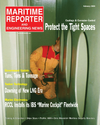
Page 16: of Maritime Reporter Magazine (February 2, 2005)
Read this page in Pdf, Flash or Html5 edition of February 2, 2005 Maritime Reporter Magazine
16 Maritime Reporter & Engineering News calculating the tax or duty to be assessed against ships calling in their ports. When the United States Government was established, the Constitution specifically provided that Congress had the power to lay and collect taxes, duties, imposts, and excises. Further, the Constitution specifically prohibited the various states (without the consent of Congress) from laying "any Duty of Tonnage". The
Customs Service (now called Customs and Border Protection) is charged with assessment and collection of tonnage taxes and light duties. Both the tonnage tax and light duty (or light money) are assessed based on the ship's net tonnage, as well as its registration and the loca- tion from which it arrives. Exemptions are provided for ships registered in nations that grant reciprocal exemptions for U.S. ships. Nations and at least two international waterways (the Suez and
Panama Canals) developed over time different methods for computing ton- nage as a measurement of capacity.
After all, you could hardly go through the exercise of stuffing tuns into every newly-built ship to determine its ton- nage. The methods became very com- plex (sometimes called fantastical) and were only understood by specialists called admeasurers. In an effort toward uniformity, the International Convention on Tonnage Measurement of Ships, 1969 was developed under the auspices of the International Maritime
Organization (IMO). The Tonnage
Convention established uniform princi- ples and rules with respect to determina- tion of tonnage on ships engaged on international voyages. The Convention is generally forward-looking. Thus, ships predating adoption of the
Convention are allowed to retain their old tonnage measurements for twelve years in the absence of a major rebuild.
Even after twelve years, pre-existing ships may retain their old tonnage meas- urements for the purpose of application to them of relevant requirements under other existing international conventions.
The U.S. legislation and regulations adopting the Tonnage Convention for ships of the United States provide details on whether the new convention tonnage measurement or the old regulatory ton- nage measurement is to be utilized by pre-existing U.S. ships to determine application of various international con- ventions and U.S. laws. The matter can quickly get very complicated, particu- larly with regard to such things as the
International Safety Management (ISM)
Code and the Global Maritime Distress
Safety System (GMDSS). Technically, both are part of the Safety of Life at Sea (SOLAS) Convention, but they are treat- ed as new requirements for purposes of application of the Tonnage Convention.
The United States now has four sys- tems for measuring tonnage of ships. In addition to convention tonnage, a ship of the United States may be eligible for measurement under the regulatory sys- tem, the dual tonnage system, or the simplified measurement system. The dual tonnage system is basically a grandfather clause for U.S. ships built before September 29, 1965, when the regulatory system became controlling for most domestic purposes. The simpli- fied measurement system is available to vessels that are either not self-propelled, under 79 feet in length, or operated for pleasure only. The drinking habits of the British peoples have thus laid the basis for an extremely complex system or systems of maritime regulation that no one person (clearly not this writer) fully understands.
NAVAL ARCHITECTS
MARINE ENGINEERS
Aker Marine
TECHNOLOGY FOR
MARINE PROJECTS www.akermarine.com
Vancouver, BC, Canada
Tel: +1 604-730-4200
Fax: +1 604-730-4297
Email: [email protected]
Houston, TX
Tel: +1 713-981-2012
Fax: +1 713-270-2944
Email: [email protected]
Preferred for innovation
New LNG Ship Concept 40,000 DWT Product Carrier • VIN #: 545995 Hull #: 1101 • 167.5’ Offshore Supply Vessel • Width: 38’ • Depth: 12.6’ • Year: 1973 • Twin Cat D398 12
Cylinder engines • Gross Tonage: 198 • Twin Disc Model MG- 540 Marine reverse gears w/ hyd clutch 4.5:1 Ratio • Keel Cooler System • Bow Thruster powered by GM-8V71 • (2) 175KW Generators pwd by GM8V71’s • 15HP 4” & 10HP 3” Ballast Pumps, • (2) Air Compressors • (2) Freshwater Pumps • Hyd Steering • Central A/C unit • Kenmore elec. washer & dryer • 20gal elec Water Heater • Eltech Sanitation Unit
Call for inspection!!! 225.686.2252
Featured OFFSITE ITEM Offshore Supply Vessel Located In Morgan City, La
M/V Southern Endeavor
VISIT OUR WEBSITE FOR DETAILED LISTS AND PHOTOS:
WWW.HENDERSONAUCTIONS.COM
HENDERSONAUCTIONS
Phone (225) 686-2252 Fax (225) 686-7658 www.hendersonauctions.com
SALES
CONDUCTED
BY:
MARVIN A. HENDERSON
LA LIC 136-05
TRUCK TRACTORS • MIXER • DUMP • ROLLBACK • FLATBED DUMP • FLATBED • SERVICE • SPECIALTY •
UTILITY • WRECKER • CAB & CHASSIS • REEFER • PICKUPS • AUTOS • TRACTORS • IMPLEMENTS • TRAILERS • MOTORCYCLES • ATVS • GOLF CARTS • DOZERS • EXCAVATORS • END DUMPS • MOTORGRADERS • STA-
BILIZER • RT LOADERS • LOADER/BACKHOES • SKIDSTEERS • COMPACTION • TRENCHERS • PAVERS •
SWEEPERS • LUBE TRUCK • SPECIALTY EQ • RT CRANES • TRUCK CRANE • BOOM TRUCKS • FORKLIFTS •
ATTACHMENTS • COMPRESSORS • WELDERS • GENERATORS • PUMPS • LEVELS • MISC
CONSTRUCTION CRANES, TRUCKS, TRAILERS, FARM EQ
MARCH 2005 • DATE TBA
HENDERSON AUCTIONS FACILITY • HWY 190, LIVINGSTON, LOUISIANA
UPCOMING PUBLIC AUCTION
Circle 202 on Reader Service Card
Circle 222 on Reader Service Card
Government Update
MR FEBRUARY 2005 #2 (9-16).qxd 2/2/2005 9:25 AM Page 8

 15
15

 17
17
